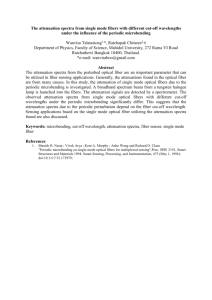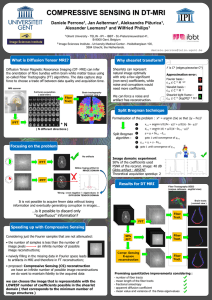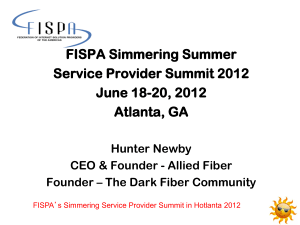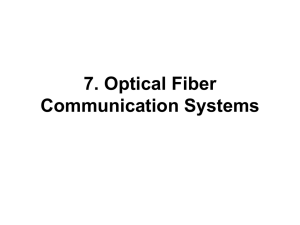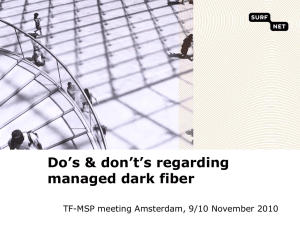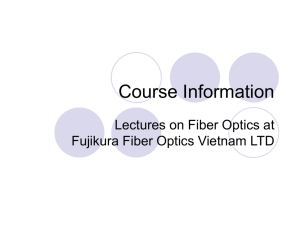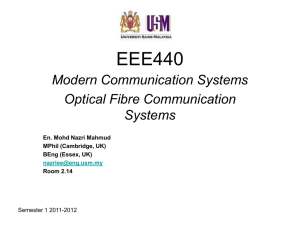Introduction to Fiber Optics - Alliance for Community Media
advertisement
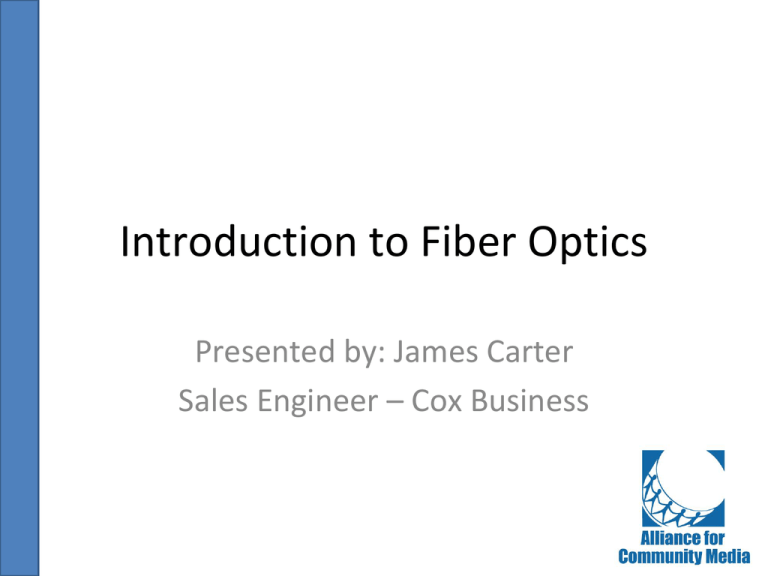
Introduction to Fiber Optics Presented by: James Carter Sales Engineer – Cox Business Scope This presentation is designed to give a general overview of fiber optic theory, its construction, the two basic types of fibers, and the benefits of fiber networks over traditional copper based networks. Content • • • • • • • • • • Terms Definition Quick history Wavelengths of light Anatomy of a fiber Types of fiber Model of a simple fiber optic link Benefits over copper-based networks Fiber optic applications CATV applications Terms • Attenuation: Attenuation is a general term that refers to • any reduction in the strength of a signal. • Bandwidth: The amount of data that can be passed along a • communication medium in a given period of time. • • • • Decibel (dB): A unit used to express the difference in intensity, usually between two acoustic, light, or electrical signals. In fiber optics, the decibel is combined with the kilometer (dB/km) to form the unit for measuring attenuation (signal loss) in a section of fiber. • Electromagnetic Spectrum (EMS): This is a term that scientists • use when they want to talk about the vast range of energy • that radiates in every corner of the universe. Terms - cont. • • • • • Electromagnetic Interference (EMI): A disturbance that affects electrical circuits. It can degrade AM/FM radios, cell phones, television reception…. It can occur naturally – sun flares, or artificially. Any electronic device ever invented has the potential to generate interference. • • • • Fiber-to-the-X (FTTX): A catch all acronym for all of the variations on the use of fiber between the service and the customer. These Include fiber-to-the-node (FTTN), fiber-to-the-curb (FTTC), fiber-tothe-home (FTTH), and fiber-to-the-premise (FTTP). • Kilo (k): A prefix in the International System of Units denoting the • number 1000. For example, a kilometer = 1000 meters. Terms – cont. • Local Area Network (LAN): A local area network is a computer network covering a small physical area, like a home, office, or small group of buildings, such as a school, or an airport. • LASER: A laser is a device that emits light through a process called stimulated emission. In communication networks, a LASER is used • to convert electrical signals (radio frequencies), into light signals. • Master Telecommunications Center (MTC): The central location where Cox Communications, acquires and combines, all the • services that are offered to our customers. The MTC is also • known as a “headend”. • Metropolitan Area Network (MAN): A large LAN that typically can • span up to 50km. Terms – cont. • Micron (μ): A unit of length equal to one millionth of a meter. • Nano (n): A unit of length equal to one billionth of a meter. It is • commonly used in fiber optics to differentiate between the various wavelengths of light. For example, the color blue has a wavelength of 475 nanometers. • Optical receiver: In communication networks, it is the device that • receives the light signals from a LASER and converts the light • signals back to electrical signals (radio frequencies). Terms – cont. Radio frequencies (RF): That part of the vast electromagnetic spectrum that can be harnessed for such purposes as Terms – cont • Secondary Telecommunications Center (STC): The STC is a • smaller version of the MTC. The STC is also referred to as a “hub”. • Wide Area Network (WAN): Whereas a LAN (local area network) is a network that links computers, printers and other devices located in an office, a building or even a campus , a WAN (wide area network) is a system that extends for greater distances and is used to connect LANs (local area networks) together. A WAN can encompass • networks across a state, the country as a whole, or the world. Definition • • • • • An optical fiber is a glass or plastic strand that can carry information in the form of light, along its length. Optical fibers are widely used in communications because they permit transmissions over longer distances and at higher bandwidths (data rates) than traditional copperbased networks. • With very low attenuation ( signal loss), immunity from all electrical • interference, and high bandwidth capacity, optical fibers are almost • the perfect medium for communications. Quick History • • • • • • • • • • Though the use of fiber optics is common in modern communication networks, the guiding of light through a clear medium is a fairly simple concept. Using a container of water, and a simple light source, Daniel Colladon and Jacques Babinet demonstrated the guiding of light in Paris in the early 1840s. Light Water reservoir source Light carried by water stream Quick History – cont. • • • • • In more modern times, scientists worked on developing a fiber so pure that when a light source was introduced at one end, after a distance of one kilometer, one per cent of the light remained. In terms of attenuation (signal loss), this was equal to 20 decibels – the existing transmission distance for a copper-based telephone system. • • • The crucial attenuation level of 20 decibel per kilometer was first achieved in 1970 by Drs. Robert Maurer, Donald Beck, and Peter Schultz, of glass maker Corning Incorporated. They demonstrated a fiber with an attenuation of 17dB/km. • • • A few years later they produced a fiber with an attenuation of only 4dB/km. This enabled General Telephone & Electronics to sent the first live telephone traffic on April 22, 1977, in Long Beach, California. • • • • Today, the purity of glass enables attenuation levels of 0.35dB/km @ 1310nm, and 0.5dB/km @ 1550nm. Combined with improvements in LASERs, optical receivers, and other optical components, optical networks can transmit digitized signals long distances – in many cases without the need of optical amplifiers. Wavelengths of light • • • • • • You may not be aware of it, but the electromagnetic spectrum is quite familiar to you: The microwave you heat your food with, the cell phone you keep in touch with, your favorite television show, the light from the sun that both warms and burns, plus the light your eyes use to see; it is all part of the electromagnetic spectrum. Wavelengths of light – cont. Visible light: 650nm 400 700 Light not visible to the naked eye: wavelength • 1310 nm • 1550 nm Anatomy of an optical fiber Three functional components: Core Silica glass with Germania Purpose – signal transmission Cladding Silica glass Purpose – signal containment Coating Dual-layer, UV cured acrylate Purpose – mechanical protection Types of fibers • Putting the micron (μ) in perspective • A human red blood cell is 10 microns across. • A human hair ranges from 40 – 120 microns wide. •The period at the end of this sentence is about 397 microns. • The eye of a typical needle is 749 microns wide. • A postage stamp is @ 25,400 microns long. Types of fibers – cont. 50 & 62.5 microns Cladding 125 microns Plastic Coating 250 microns Multimode 8 – 10 microns Single-mode 125μm 250μm Types of fibers – cont. Multimode fibers Advantages Disadvantages • Uses inexpensive light sources • Uses low cost connectors that are easy to install • Easier and cheaper to install • Works well for LAN, college campus networks • Easier to splice when cut • Can handle high data rates • Optimized for distances less than 2Km • Higher attenuation than single-mode fiber Types of fibers – cont. Single-mode fiber Advantages • Optimized for long haul applications • Very low attenuation • Light can reach distances of @ 50 miles without the need of optical amplifiers • Can handle high data rates Disadvantages • Uses expensive LASERs as a light source • Difficult to install connectors • Higher installation costs • More susceptible to damage during installation • More difficult to splice when cut Types of fibers – cont. Attenuation: Single-mode vs. Multimode Single-mode Multimode Types of fibers – cont. 250μm Single bare fiber 900μm Single fiber strand with additional white plastic coating Types of fibers – cont. Fiber glass support Buffer tubes Rip cord Armor Individual fibers Mylar wrap Plastic • Up to 432 fibers for single-mode cable Fiber optic link fiber Information Source LASER Optical Receiver Model of "simple" fiber optic data link Information To Customer Benefits vs. traditional networks • • • • • • • • Not susceptible to electromagnetic or other types of electrical interference Not affected by temperature No amplification required up to @ 50 miles Greater information carrying capacity Lightweight More secure Less attenuation than copperbased cables Improved quality of the signals transmitted Benefits vs. traditional networks - cont. Why use fiber? • Capacity of 2400 pair copper telephone cable: - 1 call per copper pair • Capacity of a single fiber: - > 500,000 calls • Size and weight – To transmit equivalent information 1 mile • Single fiber cable =28 lbs • Equivalent capacity copper cable = 33 tons Fiber optic applications MAN/city rings 10 - 200 km LAN AB B Access A B B Long Haul A B A -WAN -Cross-country/Intercontinent -Submarine >200 km Metro A Fiber-to-the-X (curb, building, home) 0-10 km LAN 0-2 km Cable applications Cable Networks MTC Tree-and-Branch Service Area Long cascade of amplifiers Microwave HUB Hybrid-Fiber-Coaxial Service Area Service Area Cable applications – cont. Ring-in-ring HFC Network MTC Hub/STC Fiber Transport Network Fiber Access Network Distribution Amplifier Coaxial Access Network Line Extender Amplifier
